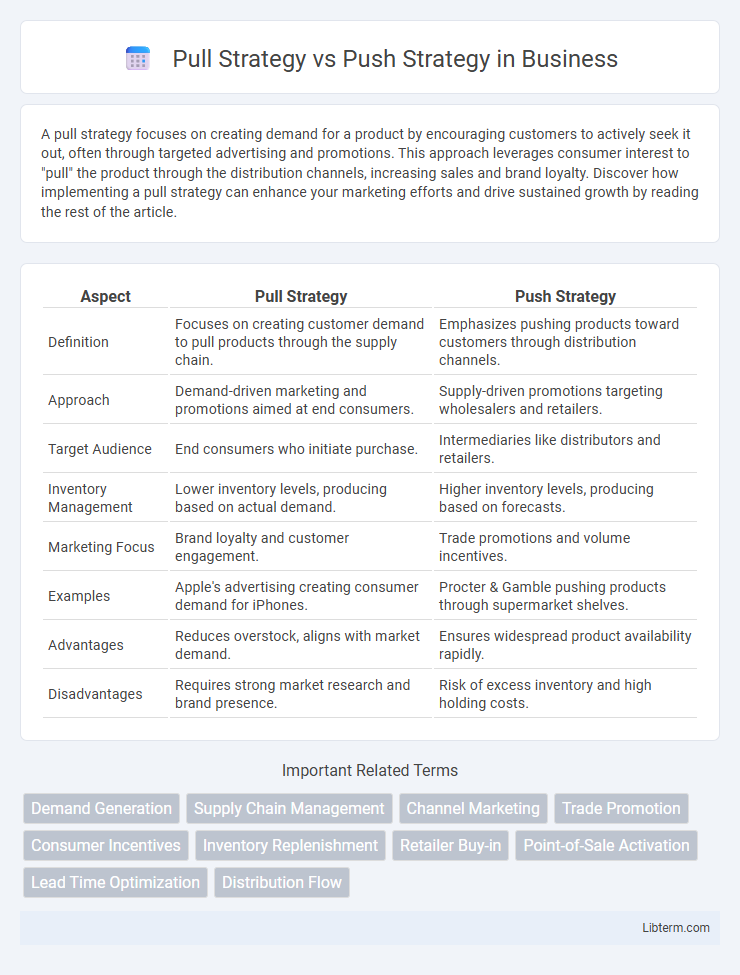A pull strategy focuses on creating demand for a product by encouraging customers to actively seek it out, often through targeted advertising and promotions. This approach leverages consumer interest to "pull" the product through the distribution channels, increasing sales and brand loyalty. Discover how implementing a pull strategy can enhance your marketing efforts and drive sustained growth by reading the rest of the article.
Table of Comparison
| Aspect | Pull Strategy | Push Strategy |
|---|---|---|
| Definition | Focuses on creating customer demand to pull products through the supply chain. | Emphasizes pushing products toward customers through distribution channels. |
| Approach | Demand-driven marketing and promotions aimed at end consumers. | Supply-driven promotions targeting wholesalers and retailers. |
| Target Audience | End consumers who initiate purchase. | Intermediaries like distributors and retailers. |
| Inventory Management | Lower inventory levels, producing based on actual demand. | Higher inventory levels, producing based on forecasts. |
| Marketing Focus | Brand loyalty and customer engagement. | Trade promotions and volume incentives. |
| Examples | Apple's advertising creating consumer demand for iPhones. | Procter & Gamble pushing products through supermarket shelves. |
| Advantages | Reduces overstock, aligns with market demand. | Ensures widespread product availability rapidly. |
| Disadvantages | Requires strong market research and brand presence. | Risk of excess inventory and high holding costs. |
Introduction to Pull and Push Strategies
Pull strategy focuses on creating consumer demand to draw products through the distribution channel, leveraging advertising and promotions to attract customers directly. Push strategy emphasizes motivating intermediaries, such as wholesalers and retailers, to stock and promote products to end consumers. Understanding these foundational approaches helps businesses tailor marketing efforts to effectively manage supply chain dynamics and consumer engagement.
Defining Pull Strategy in Marketing
Pull strategy in marketing focuses on creating strong consumer demand by encouraging customers to actively seek out a product, often through targeted promotions and brand loyalty efforts. This approach relies on stimulating interest and desire through advertising, social media engagement, and content marketing to attract buyers directly. Pull strategy effectively builds long-term brand equity by driving consumer preference and increasing product visibility in the marketplace.
Understanding Push Strategy in Marketing
Push strategy in marketing involves promoting products by pushing them onto consumers through channels such as wholesalers, retailers, or sales teams, aiming to create demand at the distribution level. It relies heavily on trade promotions, direct selling, and point-of-sale displays to encourage immediate purchase and increase product availability. This strategy is effective for new product launches, short-term sales boosts, and markets where consumers have limited product knowledge or require incentives to try new products.
Key Differences Between Pull and Push Strategies
Push strategy emphasizes proactive promotion by directly delivering products or messages to consumers, leveraging channels like sales teams and trade shows to stimulate demand. Pull strategy relies on creating consumer demand through advertising and marketing efforts that encourage customers to seek out the product, often utilizing social media and content marketing. The key difference lies in push driving supply towards consumers, while pull generates consumer interest that pulls the product through the distribution channel.
Advantages of Pull Strategy
Pull strategy enhances customer engagement by creating demand through targeted marketing efforts, leading to higher brand loyalty and stronger customer relationships. It reduces inventory costs and minimizes the risk of overproduction by aligning supply with actual consumer demand. This approach fosters sustainable growth by encouraging repeat purchases and leveraging word-of-mouth promotion.
Advantages of Push Strategy
Push strategy drives products directly to customers through aggressive sales tactics and distribution channels, ensuring immediate market presence and rapid inventory turnover. It allows for better control over the supply chain and inventory management, reducing stockouts and enabling precise demand forecasting. This approach is particularly effective for new product launches and industries with short product life cycles, maximizing reach and sales volume in a controlled manner.
Challenges of Implementing Pull vs Push
Implementing a pull strategy often faces challenges such as accurately forecasting consumer demand and maintaining sufficient inventory to avoid stockouts, which can result in higher operational costs. Conversely, push strategies struggle with inventory surpluses and the risk of obsolescence due to production based on predicted demand rather than actual consumer needs. Both approaches demand robust coordination across supply chain nodes, but pull strategies require more agile demand sensing technologies, while push strategies rely heavily on efficient production planning and distribution logistics.
When to Use Pull Strategy
Use a pull strategy when targeting well-informed customers who actively seek product information or when building brand loyalty is critical. This approach excels in markets with high competition and product differentiation, where consumer demand drives sales. Businesses with strong digital presence and content marketing capabilities benefit the most from pull strategies to attract and engage potential buyers.
When to Use Push Strategy
Push strategy is most effective when launching new products or entering new markets where consumer awareness is low. It relies on aggressive sales tactics and trade promotions to motivate intermediaries such as retailers and wholesalers to stock and promote the product. This approach ensures rapid product distribution and availability, driving immediate sales volume and market penetration.
Choosing the Right Strategy for Your Business
Selecting the appropriate marketing approach depends on your business goals, target audience, and product lifecycle stage. Pull strategy excels in building long-term brand loyalty by attracting customers through content marketing and organic search, ideal for established brands with strong market presence. Push strategy drives immediate sales via direct promotions and salesforce efforts, suitable for new product launches or when entering competitive markets.
Pull Strategy Infographic

 libterm.com
libterm.com